|
Nature is full of example of apparent miracles and none of them greater than the miracle of tuberous begonias.
From a single seed the size of a grain of sugar grows a plant easily surpassing 1.5 foot tall and wide with large, colorfull flowers.
While still a miracle, it is somewhat intuatively easier to
comprehend that an acorn over a period of 20 years grow into a big tree, after all that is a long time and the acorn is big enough that you can hold and feel it your hand. Even annual flowers growing from a pin head size seeds can be admired but still be set in relation to the 10" size with it's 2" flowers.
However, a tuberous begonias with 4" flowerheads resembling ruffled or rose form flowers growing from the size of of a pin prick in just 26 weeks is purely amazing.
Any professional or amateur seed grower who has been bitten by the bug will no doubt have to grow begonias from seed, if nothing else than just to say
that "they did it". They, too, performed magic. No it is not 'water into wine' or 'copper into gold'.. it is much better: it is the ultimate trick of the 'tuberous begonia'.
|
|
Seeds from tuberous begonias are extremely small
(about 1,000,000 seeds/oz). Compare this to impatiens seeds, for example, which often
are said to be small (35,000-65,000/oz). A good illustration would be to compare
an impatiens seed to the length of a regular ballpoint pen and the begonia seed
to the width of the pen. No matter how you compare them, begonia seeds are so small
that they at first glance appear to be no bigger than a speck of dust, although I find that
to be a bit of an exacteration. Take a look at picture 1 and picture 2 to the right for a good idea
of how small the seeds are.
|
|
Sowing the seeds are not difficult, but one needs to be carefull and choose between
a number of suggested methods.
Normally I sow small seeds (coleus, impatiens,
petunias) by emptying the seeds into a bowl and transfer them to the pot using a moist
end of a toothpick. This will not work with begonia seeds, however, as they would
simply disappear.
It has been suggested to mix the seeds with fine silver sand or suger and it may work,
but my preferred method, which works pretty well, is to use a folded piece of carton stock paper.
If you can buy pelleted seeds, this is obviously also an option.
|
|
This method is actually easier than it may appear in writing. I use a stiff paper
(carton stock) folded in the middle (picture 6). Using a knife I transfer a suitable amount of
seeds and by knocking on the backside of paper with your fingers you can make the
small seeds fall into the crease.
The objective is to space the seeds evenly along the
crease. You will soon get the hang of it after a few trials (and after you learn not to
breathe too hard on the paper at the same time. 'Waiting to exhale' is the title we are
looking for).
When the seeds are evenly spaced you tip the paper to an angle and keep
knocking with your fingers under the paper to make the seeds roll of one at a time, or
atleast not too many at a time. As you go along move the paper over the top of the pot to
distribute the seeds evenly accross the surface, or into individual compartments if you
used celled flats (picture 9).
The folded paper method is actually amazingly easy and effective.
|
|
Unless you are planning on growing a very large amount of begonias you are
probably better off using a small pot or container for the initial sowing.
I use 3" square pots, but any container with drainage holes will work. Especially
if you are growing different cultivars or types having a number of small 3" pots is
better than one large seed flat. This also becomes an advantage if damping off disease should attack one
pot. At least you don't loose your entire sowing.
Due to the very small seeds, tuberous begonias are
very susceptible to damping off (disease) and cleanliness is a virtue. I soak the
pot in a diluted bleach solution (1 part clorax bleach to 9 parts water) for a few
minuttes and then rinse carefully with clean water.
As growing medium I use commercial
seed starting mixes which are "soilless" and free of pathogens. You can mix your own if
you like, but I suggest you avoid garden soils for the same reason (picture 5).
I like to top off the
container with a 1/8" layer of vermiculite. It helps conserve moisture around the small
seeds, helps create an even surface on which to sow, and will aid in the prevention of
green mold. Green mold can appear when the growing medium is exposed to consistent
humid conditions under moderately low temperatures (a.k.a. begonia seed germination environment).
I have found that containers topdressed with vermiculite before planting did not produce
green mold. Since the begonia seeds are very small they will every easily fall through the
open spaces in traditional seed starting mix and being too weak to grow out of even
relatively shallow pockets they require an even firm surface on which to rest. You do not,
however, add vermiculite after sowing (begonia seeds do not get covered), only before
sowing the seeds.
|
|
Before you start make sure the germination medium is thoroughly wet. I usually put the pot in a pan of
water to soak up moisture untill the vermiculite on top turns dark gray. The let it drain for 30 minuttes.
I use warm water to avoid saturating the medium with too cold water which can inhibit germination, but please let
it cool to 70 deg F before sowing or you risk cooking the seeds (picture 4). Tuberous begonias germinate best at temperatures between 70-75 deg F, e.g.
try to target 72 deg F like most other annual seeds.
|
|
In the process of sowing the seeds you will inevitably sow more seeds than you need or had planned. Unless you use pelleted seeds which allow you to place
each begonia seed in individual compartments in seed starting flats, even the best of methods will result in many more seeds being planted and often close together.
By excercise some care you can do you best to keep the over crowding to a minimum which will help you when it is time to transplant the seedlings.
It is impossible to avoid some over crowding, however.
As the seedlings germinate and starts to grow they will soon become overcrowded and
must be transplanted. Depending on how close the seeds were sown this may happen sooner or later. Generally it is
preferred to sow the seeds with greater distance between them and allow them more time in the growing medium before having to
transplant. The earliest you can transplant them is usually when both cotyledons (seed leaves) are unfolded but the seedlings are extremely
small and difficult to handle at this stage. It is better to wait untill the first true leaf is about 1/2" wide.
Begonias, as opposed to many other annuals, will produce one leaf at a time instead of pairs of two leaves.
In this connection, some retailers will sell begonia seeds in packs of 25, 30 or 35 seeds which is almost impossible to control unless they are pelleted.
If you buy seeds buy preferably several hundreds and many seeds will get lost in the process of sowing, germination, transplanting and growing on. If your pack of 25 seeds
should happen to fall off the paper in one lump you may get only 1 or 2 viable seedlings as result whereas a pack of 250 seeds may produce 100-150 good seedlings, and probably many more
than you will ever need in one go unless you are a professional grower in which case you anyway will be using automated sowing machines.
In the example to the right I sowed at least 100 seeds (probably more) and my intention is to target about 30-40 good seedlings. Initially I will transplant as many as I can (100 or more) and
since not all will survice I hope to have atleast 40-50 for next transplanting that should be enough to ensure 30-40 in 6 months.
|
|
|
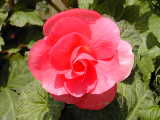
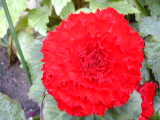
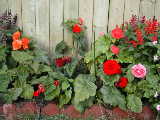
|
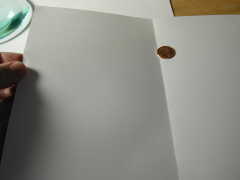
Pic 1: To give an indication of how small the seeds really are, look at this picture. Can you see the seeds ? |
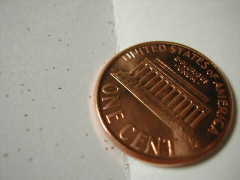
Pic 2: Here are the same picture close-Up. The seeds can easily fly away, so work in a room with closed doors and windows and take your time.
|
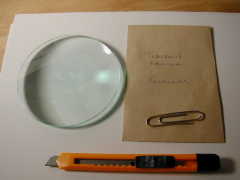
Pic 3: Equipment needed: Seeds, sharp knife, magnifying glass, and carton paper. |
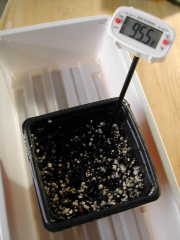
Pic 4: Thoroughly wet germination medium with hot water and let cool to 70 deg F before sowing. |

Pic 5: To succeed you must use sterile soil. I prefer ready made seed growing mix topped with a thin layer of vermiculite to help with green mold. |
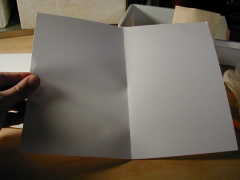
Pic 6: To preparre for sowing, fold the carton paper so a crease is created in the middle. This crease will be used as a guide for the seeds |
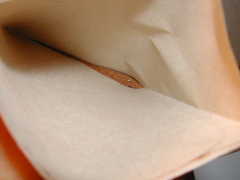
Pic 7: In this corner of the envelope are several thousand seeds. It is impossible to sow only a few so buy many. Don't buy packs of 20-25 seeds (it will be very hard to control). |
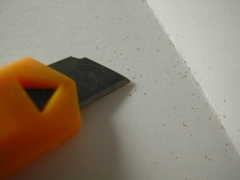
Pic 8: With the edge of a knife carefully move a minute amount of seeds to the paper. I moved maybe 100. Any shaff (waste) can easily roll off by lifting the paper and tapping with your fingers underneath. The seeds will stay on the paper. Any remaining shaff can be flicked of with the knife. |
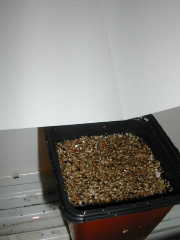
Pic 9: To sow the seeds, tip the paper and carefully tap the back of the paper. The seeds will roll off the crease in the paper which is moved around over the surface of the pot to ensure even distribution. |
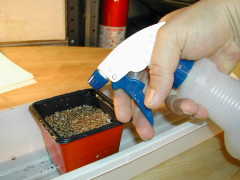
Pic 10: After sowing mist the top of the growing surface with a very fine mist to ensure the seeds have made contact with the growing medium. |
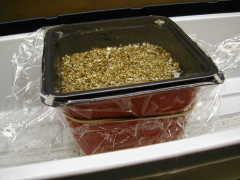
Pic 11: Cover with a piece of plastic wrap to maintain humidty. The plastic will stay on for another 45-60 days, long after the seeds have germinated, as begonia seedlings are very sensitive to drafts. |
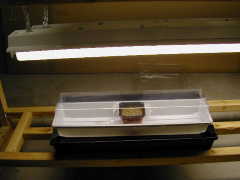
Pic 12: All done. The seeds goes under flourecent lights which are left on for 24 hours per day initially. Make sure to maintain a temperature of 70-75 deg F at all times. |
| |
|
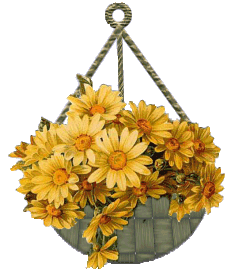 GARDENCOLORS
GARDENCOLORS



